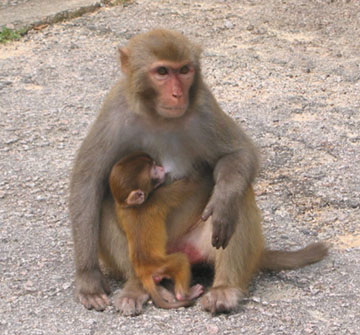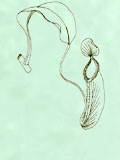
Vertebrates (pdf)
Macaques as seed predators and dispersal agents in Hong Kong
The macaques are the youngest and most successful of the major evolutionary radiations of non-human primates, which perhaps explains why they so often seem to behave like unruly teenagers. Their recent arrival in the Asian region means that there has probably not been enough time for plants to evolve specific adaptations for seed dispersal by macaques, or specific defenses against seed predation by them. The ground beneath a fruiting tree after a troupe of macaques has left tends to look like the aftermath of a wild and drunken party, and it is difficult to ascertain whether the net effect on the tree has been positive or negative. Macaques in the frugivore-rich forests of Southeast Asia are arguably eating fruits that would have been better – from the plant’s point of view - left for a kinder, gentler and more effective dispersal agent. Where the diversity of frugivores – particularly large frugivores – has been reduced by isolation or hunting, however, macaques may be the only seed dispersal agents for some plants (Lucas & Corlett 1998).
Hong Kong is well within the natural range of the Rhesus Macaque, Macaca mulatta, but as far as can be determined, this species was locally extinct by the nineteenth century and all macaques in Hong Kong today result from introductions that apparently started around 1915 (Wong 2001). The majority of the approximately 1200 macaques are M. mulatta, but there have also been releases of a closely related Southeast Asian species, the Long-tailed Macaque, M. fascicularis, which has hybridized with M. mulatta, and a few individuals of several other species. Macaques are the largest frugivores in modern Hong Kong, so their impact on the plants they eat is of considerable importance.
The macaques are the most omnivorous of primates, but studies of diet in relation to food availability have shown that they prefer to eat fruit when it is available (e.g. Lucas & Corlett 1991; Hanya et al. 2003). Indeed, when fruit is in surplus supply they hardly eat anything else. Clearly, omnivory in macaques is imposed, not chosen. Frugivorous primates usually consume only the fleshy part of the fruit, so the seeds, which are hard and often poisonous, are an unwanted waste product. The fruit-eating Old World monkeys (Cercopithecinae), which include the African guenons and Asian macaques, have well-developed cheek pouches. These are used to hold excess fruits, which are then returned one at a time to the mouth for processing, with the larger seeds being dropped or spat out and only the smallest ones (< 3-4 mm diameter) swallowed (Corlett & Lucas, 1990). This allows these monkeys to harvest many fruits quickly and process them more slowly as they move between fruiting trees. Most other primates lack cheek pouches and swallow most seeds. This also permits rapid harvesting, but has the disadvantage that indigestible seeds can make up large proportion of the material in the gut at any one time. Both seed-processing strategies seem to work equally well for the primates, but may have very different consequences for the plants whose fruits they consume.
Macaques drop and spit many seeds under the parent tree while feeding, but they also carry some fruits away in their cheek pouches and spit out the seeds one by one as they move through the forest. Seeds that are swallowed by macaques and other primates, by contrast, end up in the faeces, usually a long way from the fruiting tree. In large primates, such as the macaques, large numbers of seeds may be deposited in a clump, particularly if they defecate on the ground or from a low branch. Some smaller primates, however, such as the Neotropical tamarins, defecate large seeds singly and small seeds in small clumps, while the faeces of canopy primates, such as gibbons, often shatter before they reach the ground.
 |
| Fig. 1. Macaque mother and baby (Photo: Laura Wong) |
The macaques in Hong Kong eat a huge range of fruit species (Fellowes 1992; Corlett unpublished), many of which are probably better dispersed by birds (e.g. Bridelia tomentosa), fruit bats (e.g. Ficus fistulosa) or civets (e.g. Diospyros morrisiana). In some fruits, however, the edible part is protected by a thick, resinous outer peel, which is difficult to remove without the coordinated use of hands and teeth. A tree, Garcinia oblongifolia, and a large climber, Melodinus suaveolens, are the commonest examples of such fruits in Hong Kong. The monkeys remove part of the peel with their incisors while holding the fruit in their hands. They then scoop out the flesh and seeds with their teeth and discard the rest of the peel. The seeds are spat out individually after separation from the fruit pulp in the mouth. These single seeds can often be found a long way from the nearest possible parent plant.
The potentially beneficial impact of macaques as seed dispersal agents – however inefficient – is only part of the story. In addition to dropping, spitting or swallowing intact seeds, the Hong Kong macaques also chew up and destroy many. Most of the seeds they destroy are either from unripe fleshy fruits or from ripe, non-fleshy fruits, including wind-dispersed species and members of the oak family, Fagaceae. A large aggregation of macaques in a fruiting tree in Hong Kong is, more often than not, destroying a crop of acorns (Lithocarpus spp.) or chestnuts (Castanopsis spp.). Fagaceae fruits seem to be a preferred food of all macaque species wherever they are available, and they are a life-maintaining staple for part of the year at several of the more northerly sites (Lucas & Corlett 1998). These fruits have to be edible, since they depend on scatter-hoarding rodents for their dispersal (Xiao et al. 2003). Their only defense against seed predators is a tendency to mast, i.e. produce very large crops at multi-year intervals. Only in the mast years, when the crop is superabundant, do many fruits survive to grow into seedlings.
Is the overall impact of macaques on Hong Kong’s flora positive or negative? We do not have enough evidence to say for sure. I suspect it is negative at the sites where macaques are maintained at unnaturally high densities by artificial (and now illegal) feeding. In these areas, a lot of fruit is eaten – or just bitten and discarded - before it ripens, apparently out of boredom. In areas where both diet and density are more natural, such as at Tai Po Kau, the macaques are probably benefiting some species and damaging others, much as they would have done before humans arrived. It is striking, however, that even plants with obvious "primate fruits", like the Garcinia and Melodinus mentioned above, appear to be doing fine on Hong Kong Island and Lantau, where there have been no wild primates for at least 160 years. There is a PhD project in this for somebody!
Bibliography
Corlett, R.T. & Lucas, P.W. (1990). Alternative seed-handling strategies in primates: seed-spitting by Long-tailed Macaques (Macaca fascicularis). Oecologia 82: 166-171.
Fellowes, J.R. (1992). Hong Kong Macaques. WWF, Hong Kong.
Hanya, G., Noma, N. & Agetsuma, N. (2003). Altitudinal and seasonal variations in the diet of Japanese macaques in Yakushima. Primates 44: 51-59.
Lucas, P.W. & Corlett, R.T. (1991). The relationship between the diet of Macaca fascicularis and forest phenology. Folia Primatologia 57: 201-215.
Lucas, P.W. & Corlett, R.T. (1998). Seed dispersal by long-tailed macaques. American Journal of Primatology 45: 29-44.
Wong, C-l (2001). Hong Kong Macaques. AFCD, Hong Kong.
Xiao, Z., Zhang, Z. & Wang, Y. (2003). Observations on tree seed selection and caching by Edward's Long-tailed rat (Leopoldamys edwardsi). Acta Theriologica Sinica 23: 208-213.
|
|
P.8-10 |
|
Porcupine! |
 Copyright © 2000 |
